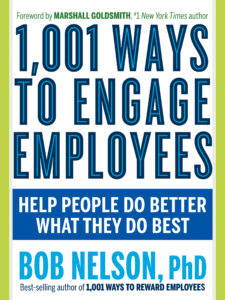Increase Employee Engagement
One of the top priorities for leaders is employee engagement. For several years, I have seen countless books and executives looking at every possible method for increasing engagement.
Bob Nelson says that it’s time to move beyond measuring it. “It’s now time to focus the behaviors that truly impact employee engagement, and not just the scores that measure it.”
In his book, 1,001 Ways to Engage Employees: Help People Do Better What They Do Best, Dr. Bob Nelson provides the methods for increasing engagement. I recently spoke with him about his new book.
Simple Things to Do Today
Share some surprising gems from the 1,001 ideas in the book.
Probably the biggest surprise for me has been the fact that the greatest motivators for today’s employees don’t require a big budget to implement, but are relatively simple, behavioral things any manager can do with their immediate team. Thanking employees for doing good work, asking for their input and ideas, providing them autonomy and authority to get their work done, involving them in decisions that affect them, two-way communication, and using mistakes as learning opportunities for them to improve are some of the key take-aways.
Which ones have gotten more enthusiastic feedback than you expected?
The book is still new, but readers in general love the real-life examples and pithy, fun quotes—both of which support the topics discussed. Hearing a great example makes readers immediately ask, “Why couldn’t we do that in our work group?” In this way, the book becomes a motivator of change: to try something new that may very well get you a better result. That’s my ultimate goal: to help people better manage their employees so they feel more valued for what they do and are more successful as a result.
And which ones might be most useful when the organization needs to bounce back from a bad shock?
Communication is critical in working with others, and you have to do more of that in tough times and times of change. Managers’ tendencies, however, are to withdraw during tough times, so you have to fight that tendency and force yourself to be out there, speaking with employees, answering questions and helping them do a better job. Likewise, for employee recognition. So many managers have an unstated assumption that they expect employees to always do good work, so they don’t have to thank them for it when they do. To the contrary, you need to proactively catch people doing good work in order to get them to more easily continue to do so. No one likes to work for a manager that only finds their faults and mistakes…
What do most managers get wrong when they think of engagement?
For most managers, “engagement” conjures up a vague and fuzzy notion of employee happiness that is not actionable on the managers’ part. This is contrary to the evidence. Specific behaviors on the part of an organization’s managers can drive employees to be more engaged with the benefits to include higher performance, better retention and a greater ability to attract talent. These specific behaviors are outlined in 1,001 Ways to Engage Employees with specific, real-life examples from companies of all sizes and types who have engaged employees.
What does an engaged organization look like?
An engaged organization has a critical mass of its leaders systematically doing the behaviors that drive employee engagement on a daily and ongoing basis.
What are a few ways to effectively recognize employees?
It all starts with a simple “thank you” when an employee does a good job. This can be done in person, in writing, electronically or in public – ideally all ways should be used. Other important no-cost ways to recognize employees include two-way communication, asking employees for their ideas and input, allowing them to pursue ideas they have, involving them with decisions (especially those that affect them and their jobs), autonomy & flexibility, and—when they make a mistake—supporting them and focusing on what they learned rather than on blame, ridicule and shaming.
Treat Employees as Partners
What does the research tell us about what makes a great manager?
A great manager does the above things, focusing on the long-term relationship with employees in a way that truly treats them as partners. When in doubt, think of the best manager you’ve had in your career and contrast that person to the worst manager you’ve had. Be more like the former and less like the latter and you’ll head in the right direction on the topic!
If a manager finds an employee is entitled and unengaged, what steps can he or she take to turn that person around?
 Communicate with the person about your perceptions of that person’s behavior and the problems that behavior is causing you, the department or the company. Solicit their support in changing his or her behavior to improve the situation. Ask what you could do to help the person make those changes. Then find some positive element that the person subsequently does and thank them for that. Positive consequences are what change desired behaviors more than anything else.
Communicate with the person about your perceptions of that person’s behavior and the problems that behavior is causing you, the department or the company. Solicit their support in changing his or her behavior to improve the situation. Ask what you could do to help the person make those changes. Then find some positive element that the person subsequently does and thank them for that. Positive consequences are what change desired behaviors more than anything else.
For more information, see 1,001 Ways to Engage Employees: Help People Do Better What They Do Best.

